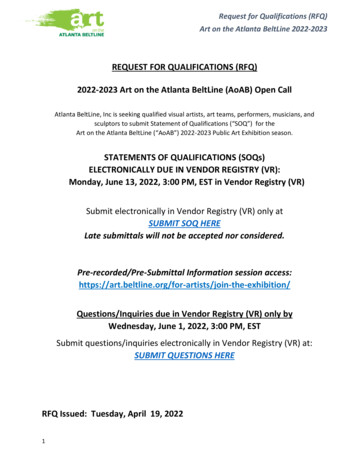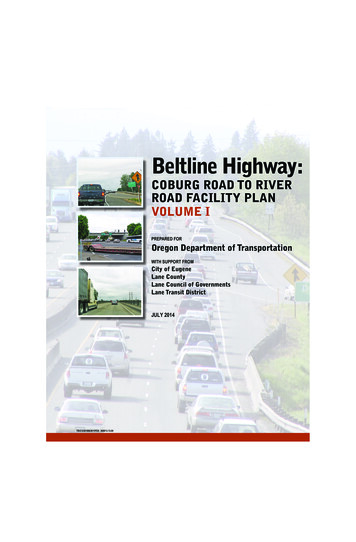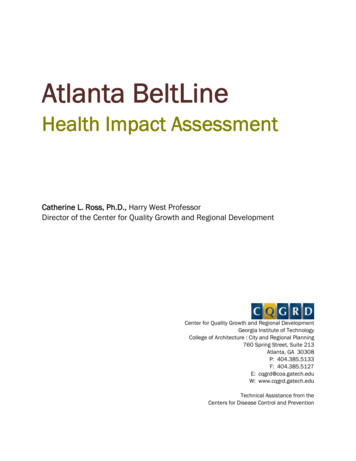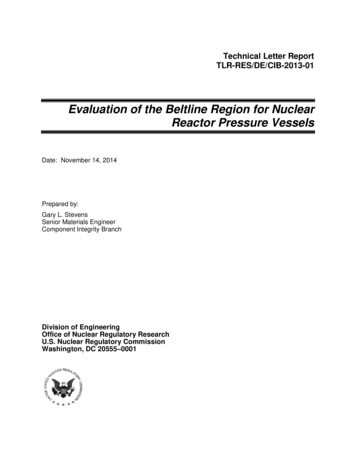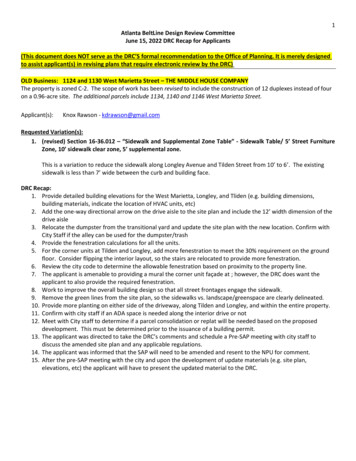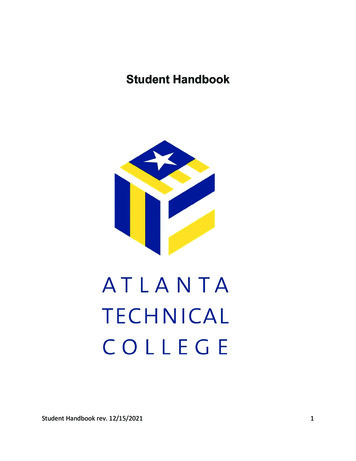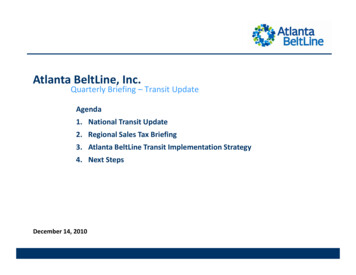
Transcription
Atlanta BeltLine, Inc.Quarterly Briefing – Transit UpdateAgenda1 National1.N til TransitTit UpdateU d t2. Regional Sales Tax Briefing3. Atlanta BeltLine Transit Implementation Strategy4. Next StepsDecember 14, 2010
National Transit UpdateNew Rail Systemsy1950s to 20101960s to 1980s – Heavy RailAtlantaSan Francisco Bay AreaWashington, DC1980s to 2000s – Lightg RailPortlandSeattleSan DiegoD llDallasDenverCharlotteThe Gold Line Light Rail in Los Angeles, California
National Transit UpdateLight Rail Project Example Project Characteristics: Service began June 2004 12 miles with 17 stations, LRT; 30,500 dailyriders Fares consistent with underlying bus network Capital cost of approximately 675m withtwo separate contracts for vehicles andrail/systems Lessons Learned: Communications & Community Relations wasa challenge during implementation Contract packaging and joint development(Metro/MnDOT) created interface issues Line has proven to be a powerful catalyst ford ldevelopmentt ini a corridoridHiawatha Line, Minneapolis
National Transit Update2000 – 2010 Streetcar ProjectsjRe‐emergeg
National Transit UpdateStreetcar Project ExampleProject Characteristics: Service began July 2001 4 miles (8‐mile loop) streetcar system with 46 stops Serves the surrounding downtown 12,000 daily riders, 23% commuter service The system is owned by the City of Portland; managed by Portland Streetcar Inc., a non‐profitpublic benefit corporation whose board of directors report to the city's Office ofTransportation; and operated and maintained by local transit authority, TriMet. Capital cost of approximately 103,150,000Lessons Learned: The first new streetcar system in the U.S. since World War II to use modern vehicles. 6B in redevelopment contributed to Streetcar. In contrast with light rail transit, generally not separated from other traffic or given any trafficsignal priority over other vehicles. Each streetcar is 66 ft long,long compared to 75‐9575 95 ft for light rail cars.cars
National Transit UpdateLRT and Streetcar Example Video
National Transit UpdateService Type Comparison LRT and StreetcarExpress Service – Typical of LRTExpanded Service – Typical of Streetcar
National Transit UpdateWhat expansionppprojectsjare underwayy rightg now?Federal Stimulus GrantsTucson – Streetcar Starter LineFort Worth – Streetcar Starter LinePortland – Roadway w/ Streetcar TrackNew Orleans –Streetcar ExpansionDetroit – Downtown LRT Starter LineCharlotte – Streetcar Starter LineAtlanta ‐ StreetcarNewe StaStartsts aandd Localoca Fundsu dsWashington, DC ‐ 2 Streetcar Starter LinesSeattle – Streetcar and LRT ExpansionCharlotte – LRT ExpansionPhoenix – LRT ExpansionSalt Lake City – LRT ExpansionDenver – LRT ExpansionHouston – LRT DevelopmentWashington, DC Streetcar System Plan and Anacostia Construction
Agenda1 National1.N til TransitTit UpdateU d t2. Regional Sales Tax Briefing3. Transit Implementation Strategy4. Next Steps
TransportationIn estment Act of 2010Investment(HB 277)
AUGUST 2010:Planningg Director submitsrecommended criteria forTSPLOST projects
WINTER 2010:Roundtable amendsand approvesppcriteria;;Elects ExecutiveCommittee
Local governments andlegislators submit projectsconsistent with thegregionalcriteria to thePlanning Director
Planning Directorpfinanciallyycompilesunconstrained example listggfrom the suggestedprojects
AUGUST 15,, 2011:Executive Committee workswith Planning Director tocreate and deliver a fiscallyconstrained draft investmentlist.
OCTOBER 1515, 2011:Executive committee holds atleast two ppublic meetings;g;Roundtable amends andapproves the finaltransportation investmentlist
2012:Election superintendentsin each of the 10 countiescall for a vote on thetransportationinvestment list and 1%sales tax.
Other Important Elements: 15% of all funds collected will bereserved for local projectsp j Citizens Review Panel will monitorproject administration and deliveryover ten years.
Transportation Investment Act of 2010Next Steps: MetroMetro area partnershipforming to educate the publicabout their options YOUR input is transportation-investment-act-of-2010
Agenda1 National1.N til TransitTit UpdateU d t2. Regional Sales Tax Briefing3. Atlanta BeltLine Transit Implementation StrategyBest Practices and OverviewProgress Update and Schedule4. Next Steps
Transit Implementation Process2010Tier 1 EIS2013Local/Small StartsNew StartsDetailed CorridorAnalysis/Tier 2Transit ImplementationStrategySt t&Regional Sales Tax ListNew Starts fundedsegmentsLocal or TIGERfunded segments2010Corridor DesignTier 2Final DesignConstruction2013PreliminaryEngineeringFinal DesignTransit Linein ServiceConstruction20162016Federald l New StartsProcessTTransitit IImplementationlt tiStrategy and FundingLocal or TIGER ProjectDevelopment Process
Transit Implementation StrategyRedevelopmentpPlan Transit Vision 22‐mile loop of LRT or Streetcarconnected to MARTA in fourplaces Transit as a tool to structure landuse and provide mobility Number of actual transit projects(segments) to achieve the loopnot specified High level funding approachthrough TAD and federal funds Transit implementation strategywill provide the roadmap forgetting transit built on theAtlanta BeltLineThe transit vision for the Atlanta BeltLine was the focus of the redevelopment plan
Transit Implementation StrategyPlans in Peer Cities Comprehensive streetcar implementationstrategies completed by: Seattle and Tacoma Portland Washington, DC Atlanta Beltline/Streetcar can be:–“City serving” and–“City shaping” Peer City implementation strategies createdby city‐level transportation agencies For implementation, the Atlanta BeltLineneeds to be broken down into segmentsconnected to other similar transit projects asshown in the Seattle Streetcar (left)
Transit Implementation StrategyPlans in Peer Cities Key Factors for Identifying Segments: Link transit destinations to createridershipid hi anchorsh ffor segmentst Serve transit supportive neighborhoods Establishing a funding model thatgeneratest locall l businessb icontributionst ib ti Lessons learned: Get started ASAP with a small segmentto demonstratedconcept Pursuing a non‐federal funding strategyreduces costs and speedsimplementationTh TacomaTheTLinkLi k Streetcar,St tWWashingtonhi t Federal funds can be used forextensions of locally initiatedstreetcar/LRT systems
Transit Implementation StrategyPlans in Peer CitiesReconnecting America TOD 201framework relating to density, land usemixi andd transiti accessibilityibili hash beenbused to plan implementation in: Los AngelesgSan Francisco Bay AreaDenverStations ttypedped as Regional,Regional Urban Center,CenterTown Center, Transit Town Center, UrbanNeighborhood, or Neighborhood7,000 persons living or working within a ½mile of a station is considered a goodbenchmark for rail transit readiness
Transit Implementation StrategyLeveraging City / Regional ConnectivityThe Atlanta BeltLine, the AtlantaStreetcar and MARTA should bedeveloped as an integrated transitsystem for the City and region.Advantages include:Atlanta BeltLine –Double GreenAtlanta Streetcar –Thin BlueMARTA – Orange Reducing competition betweenprojects Improving federal fundability Accessing regional funding Overcoming concerns about transitreadiness of the some portions of theAtlanta BeltLine corridor Maximizing opportunities for fundingpartnerships
Transit Implementation StrategyDeliverables Conceptual Atlanta BeltLine loop implementation plan Number of segments Identify key streetcar spurs to connect toexisting activity centers 20‐year financial plan to FTA standards Detailed Corridor Analysis Determination of highest priority segment(s) for implementation within next 3‐4 years Refinedf d strategy ffor ffundingd theh AtlantalBeltLineltransit Operational funding strategy Take into account current developments in federal programs and regional funding sources Facilitates inclusion of multiple Atlanta BeltLine projects at the Regional Roundtable Detailed implementation documentation for high priority segments: ProjectP j t managementt andd procurementt plansltot FTA standardst d d Segment level project finance plan
Agenda1 National1.N til TransitTit UpdateU d t2. Regional Sales Tax Briefing3. Atlanta BeltLine Transit Implementation StrategyBest Practices and OverviewProgress and Schedule Update4. Next StepsDecember 2010
Transit Implementation Process2010Tier 1 EIS2013Local/Small StartsNew StartsDetailed CorridorAnalysis/Tier 2Transit ImplementationStrategySt t&Regional Sales Tax ListNew Starts fundedsegmentsLocal or TIGERfunded segments2010Corridor DesignTier 2Final DesignConstruction2013PreliminaryEngineeringFinal DesignTransit Linein ServiceConstruction20162016Federald l New StartsProcessTTransitit IImplementationlt tiStrategy and FundingLocal or TIGER ProjectDevelopment Process
Transit Implementation StrategySchedule and Progress UpdateSchedule1. Best Practices Research – Complete2. Transit Characteristics of Potential Stations – Draft Complete3. Universe of Potential Atlanta BeltLine Implementation Segments– Draft Complete4. Refinement of Guiding Principles and Selection Criteria – Ongoing5. Screening for Segments to Submit for Regional Sales Tax List – Ongoing6. Transit Implementation Strategy Support Consultant Procurement – Ongoing7. Submission of Segment(s) for Regional Sales Tax List – January/February 20118. Tier 1 EIS Public Hearing – 1st Quarter 20119. Complete Transit Implementation Strategy for Entire Atlanta BeltLine – Fall 2011
Transit Implementation StrategyStation Area Types for the Atlanta BeltLineRegional and Urban Center stations aretransit destinations: They produce transit tripsTransit Communities can be trip producers orattractors dependingpg on land use mix –Typically have 7,000 plus workers andresidents and support rail transitUrban Neighborhoods and Neighborhoodsare not primarily transit destinations: They produce trips headed to TransitCommunities, Regional and Urban Centerstations
Transit Implementation StrategyStation Area Types for the Atlanta BeltLineafter 0‐Urban Center29 7TransitCommunity621 d130‐13
Transit Implementation StrategyProgress Update on Initial FindingsShort Term Conditions andOpportunities – The next 3‐10years1. Station areas will be mix ofTransit Communities, UrbanNeighborhoods andTransitioning Neighborhoodsthat will: Be mostly residential in nature; In aggregate produce significantnumbers of trips destined forlocations outside the corridor; To address existing congestionissues the Atlanta BeltLine corridorneeds to connect to job centersRedevelopment along the LRT /Greenway in Bilbao, Spain
Transit Implementation StrategyProgress Update on Initial FindingsShort Term Conditions andOpportunities2. Due to these projectedconditions, funding and nationalbest practices the transitimplementation strategy will: Break the AtlantaBeltLine into multiplesegments forimplementation IIncludel d combiningbi i thehAtlanta BeltLine withtransit spurs connectingto existingg activityy centerAtlanta BeltLine –Double GreenAtlanta Streetcar –Thin BlueMARTA – Orange
Transit Implementation StrategyProgress Update on Initial FindingsLong Term Conditions andOpportunities1 SStation1.i areas willill becomebTransitTiCommunities and Urban Centers.These station types would: Typically be served by asingle streetcar or LRT line; Still need connections toRegional Centers Support significantcirculation from station tostation along the corridor.Circulator projects like the Atlanta BeltLine often connect existing activity centers with areas of residential densityand redevelopment opportunity
Transit Implementation StrategyProgress Update on Initial FindingsLong Term Conditions andOpportunities2. For transit segments implementedldbeyond the next 10 years theimplementation strategy will: Identify transit spurs thatprovide direct access toregional activity centers inand around in the corridor Identify segments that willfocus on circulation withinthe Atlanta BeltLine corridorA mature LRT node in France
Transit Implementation StrategyProgress UpdateGuiding Principles and Priorities for Identifying 3‐5 year Implementation SegmentsProject Readiness: 25%Do we have the right‐of‐way?Are there engineering challenges and/or complex connections to MARTA?Fundable with TAD Bonds and other non federal funds (private contributions, MARTA, regionalTSPLOST)Practicality: 25%Transit supportive characteristics (densities, land use mix, transit anchors), 2010 and 2040RidershipCommunity support for Atlanta BeltLine objectives (land use, affordable housing, connectivity,trails and parks)Equity: 25%Improve transit access to jobs and services for transit dependent (low income, no vehiclehouseholds, age 65 households)
Transit Implementation StrategyProgress UpdateGuiding Principles and Priorities cont.Financial Leverage: 15%Competes for non‐TAD transportation investments (federal funds, MARTA, privatecontributions, regional TSPLOST)Contributes to partnerships that generate funds for sustainable and livable communitiesthrough non transportation sources (HUD, EPA, DOE)Development Impact: 10%Maximizes TAD increment growth (e.g. – City Hall East)Transit supportive land use regulations adopted
Agenda1 National1.N til TransitTit UpdateU d t2. Regional Sales Tax Briefing3. Transit Implementation Strategy4. Next Steps
Transit Implementation StrategyNext Steps: Outreach, Education and InputGeneral Public and StakeholdersBusiness Community Tonight Atlanta BeltLine Partnership 2 Citywide Briefings – January andlate Spring 2011 Atlanta Committee for Progress Community Improvement Districts Metro Atlanta Chamber ofCommerce Briefings to stakeholder groups asneeded (ongoing)Project Partners MARTA PATH, Trust for Public Land, TreesAtlanta, Park PrideRegional and State TransportationAgencies ARC, GRTA, GDOT
Atlanta BeltLine, Inc. Quarterly Briefing - Transit Update Agenda 1. Nti lNational TitTransit UdtUpdate 2. Regional Sales Tax Briefing 3. Atlanta BeltLine Transit Implementation Strategy 4. Next Steps December 14, 2010. National Transit Update New Rail Systems 1950s to 2010 1960s to 1980s -Heavy Rail .
